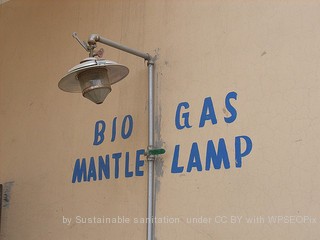We bring you the Anaerobic Digestion Basics (AD) and if you scroll down, 5 tips on how AD Works. AD is in-truth an unhelpful acronym for the basic age-old natural process that produces renewable energy as heat and biogas, and at the same time makes a natural crop fertilizer.
That, in a nutshell, is basic anaerobic digestion, and how the AD (or fermentation) process works.
How Does Anaerobic Digestion Work?
The following video is a very popular video which explains the anaerobic digestion basics of how AD works:
Anaerobic digestion happens in closed spaces where there is no air (or oxygen). The initials “AD” may refer to the process of anaerobic digestion or the built system of tanks, pipes, and pumps, where anaerobic digestion takes place, also known as a digester.
A common challenge faced by many is getting to grips with what the Anaerobic Digestion Basics are and how it works to make biogas. You won't have that problem once you have read this page!
The image on the left/above shows a lamp in which the biogas burns on the surface of a mantle of inflammable material. The result is that the mantle becomes very hot and emits a bright white light almost as good as an electric light bulb.
The difference is that this light works off-grid and all that is needed is biogas!
Anaerobic Digestion Basics – 5 Tips on How It Works for Farms and Businesses
Here are the top 5 essential points or tips about anaerobic digestion to help you succeed at understanding the anaerobic digestion basics:
1. What is Anaerobic Digestion?

Anaerobic digestion is a natural biological process that occurs when bacteria break down biodegradable material in the absence of oxygen, which creates biogas, a mixture of mainly methane and carbon dioxide with small quantities of other gases such as hydrogen sulphide.
The biogas can be burned to create heat, used to generate electricity, or used as automobile fuel.
Why should you want to do that? Well, you may need the energy to use in your business, or at home to cook food, for example, or you may wish to make a profit from selling the energy.
That can be very important now that the price of energy produced by the anaerobic digestion process tends to keep rising and can rise quite rapidly over short time periods.
With your own biogas plant you not only have a secure source of power at a known cost, but you also gain in waste management especially as a farm owner because the process converts waste to a natural fertilizer.
Overall anaerobic digestion brings many environmental solutions and that's one of the top anaerobic digestion basics to remember.
2. What is the Most Undervalued Benefit of Anaerobic Digestion
The by-product of anaerobic digestion which is the solid/liquid residue called digestate but in reality is a wonderful natural crop fertilizer is the most undervalued.
Some wonder whether making fertilizer from waste could spread disease. However, digestate used as a fertilizer is not a health risk, when created according to good practice. Where necessary, it is sanitized by pasteurization before being used.
As time goes on this benefit will become more significant because the cost of alternative (carbonaceous chemical sourced) fertilizer keeps rising. Not only that:
- the fibrous portion of digestate helps improve soil quality, and reduce erosion when spread on land
- the micro-organisms in the digestate tend to invigorate growth by becoming established in so many of our soils that have been depleted of helpful microbes by many years of chemical fertilizer application.
3. What is the Big Advantage of Renewable Energy from Anaerobic Digestion (AD)
The energy produced from digester biogas is categorized as “green energy” or “renewable energy“.
Organic waste or mixed municipal waste when processed in anaerobic digesters (AD plants) contributes to sustainable and renewable energy targets set by regional and national governments, electrical utilities, and large businesses, right across North America and Europe.
Now that many jurisdictions have set mandatory RPS (renewable portfolio targets), AD projects are becoming increasingly attractive as one of a portfolio of green energy sources that can contribute to the environmental goal.
To ensure that enough AD plants are built, tax breaks are increasingly being given to AD plant owners.
This is mainly because administrations are projecting forward to the future higher compliance targets to which they have been committed and see the need to kick-start the development of the industry.
“Always available energy when it is needed”
Another reason why this is advisable is that biogas is always available energy. Unlike solar or wind energy it can be easily stored and used at night and in cold weather.
The technology produces energy, no matter what the wind speed is, day and night, to make power and provide heat.
This is something that most other alternative renewable energy production methods are very poor at achieving.
4. Producing Biogas Can Help Raise Company Reputations in the Age of the Civil Society
In a generation where carbon trading and carbon neutrality are current hot buzzwords, anaerobic digestion is looking like an exciting new prospect to many stakeholders. Running an AD plant within a business to manage organic waste, shows to society that your business is a responsible one using sustainable practices and looking to continue to trade in the long term.
Nations like the UK are already setting targets for “Net Zero 2050” programs enshrined in national law. These programs require carbon emissions to be reduced to a net value of zero by 2050 and that's where understanding anaerobic digestion basics will help you see ways to do this.
Other types of carbon emission reductions such as through solar and wind energy are valuable but don't assist agriculture or the transport sector to decarbonize and cease carbon emissions in anything like the same direct way that the AD process can.
And why may this be important?
Well, the answer is that in a number of countries, the owner of an alternative energy plant that provides waste to energy (WTE) can offset their AD Plant's carbon benefits against the need to pay taxes through RHI rebates.
Might there be another reason?
There is. It's the digestion process.
There is, and that reason lies in the fact that more and more companies see the possession of an anaerobic digestion WtE (Waste To Energy) plant within the organisation as a way to be able to publicize their own good “green” credentials. Long-term institutional investors (e.g. pension funds) need the reassurance of in-house AD capability.
In-house AD within a business shows that they are using the advantages explained in the anaerobic digestion basics. It positively demonstrates that any company is sincere about decarbonizing.
The result is that institutional investors are more likely to invest in companies that understand and implement the anaerobic digestion basics because they can see that those businesses are going to be able to adapt and survive while being required to achieve net-zero carbon emissions by 2050.
5. Other Plus Factors
Very many Anaerobic Digestion Plants use the principle to generate heat and light, fuel, and solid by-products like soil-improvement fibre.
The raw materials that are fed can be food waste, waste from the pharmaceutical or paper industry, and animal waste, which will all produce methane and carbon dioxide.
Traces of nitrogen, carbon monoxide, hydrogen, oxygen, and other gases also get produced.
Typically, anaerobic digestion produces 50-80% of methane and 20-50% of carbon dioxide. It may be possible to separate the CO2 out and sell that profitably as well.
That's known as “carbon capture”, and it will become increasingly important for climate change reduction in the years to come.
Just what is probably the main plus factor with this?
Well. As energy prices rise it becomes more profitable to sell unwanted power. What other reasons would there be in favour of this?
This power could still be available even if the country in which the Anaerobic Digestion Plant exists goes to war with oilfields no longer producing, or shipping when blocked from international ocean routes.
A number of military establishments (e.g. the RAF in the UK, and the US Air Force and Army) operate their own anaerobic digestion plants.
Concluding – Anaerobic Digestion Basics and 5 Tips on How AD Works
Anaerobic digestion, in conclusion, is a method that can effectively transform organic waste into renewable energy and valuable byproducts while simultaneously decreasing emissions of greenhouse gases. Having read this article you should now understand anaerobic digestion basics.
You now know how the method relies on microorganisms decomposing organic matter in the absence of oxygen in nature. You now know that the process of anaerobic digestion has many possible applications, some of which include wastewater treatment plants, farms, and food processing facilities.
The quality and quantity of feedstock, the design and operation of the digester, and the management of the digestate are all anaerobic digestion basics critical to the success of anaerobic digestion. The efficiency and profitability of anaerobic digestion systems can be maximised if operators follow the advice provided in this article.
Anaerobic digestion, which converts waste into a valuable resource, will play a crucial role in achieving a more sustainable and circular economy. We can anticipate a future where waste is not a problem but a solution as the basic anaerobic digestion technology improves and more industries adopt this process.
Uncover some ways to understand anaerobic digestion plant basics by visiting this: Click here to check this out.
[The original article was first posted on 23 August 2012. Updated on 31 August 2019, and again on 22 February 2023.]





